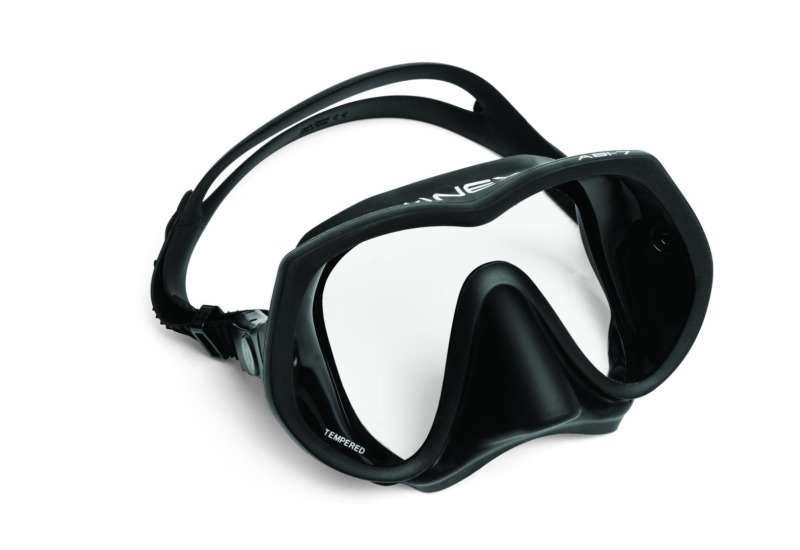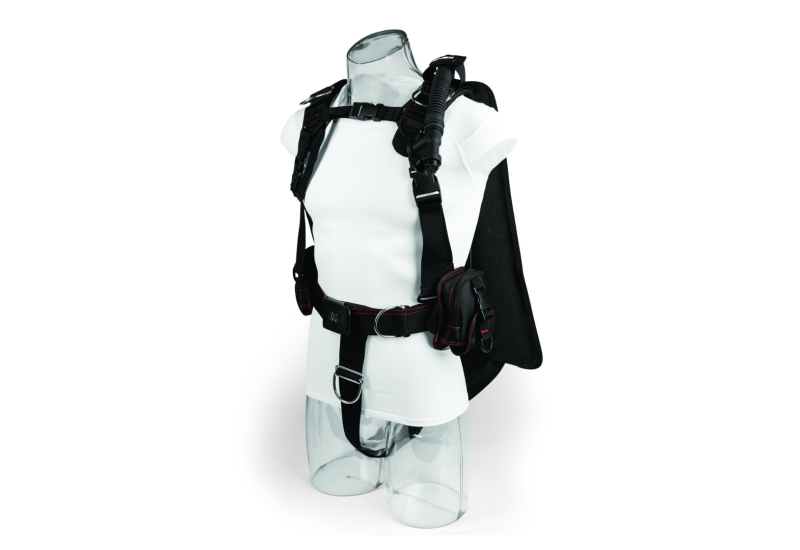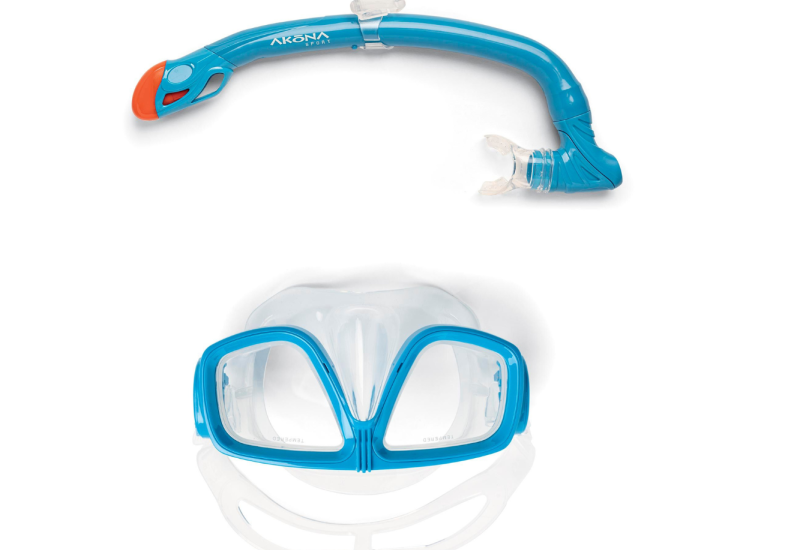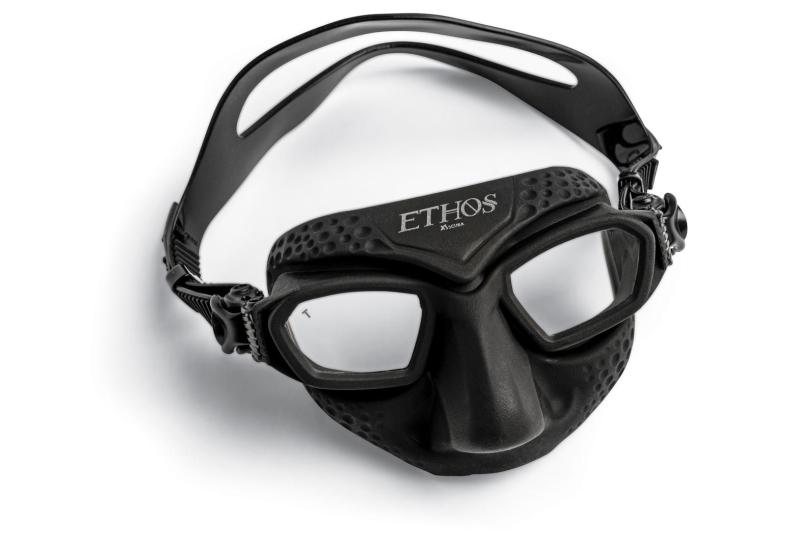The Refraction Factor
The field of view you get peering through a new mask in your dive store is not what you’re going to get peering through it underwater. Beneath the waves, field of view is going to be less, about 30 percent less. And, as we all learned in our Open-Water course, what you see is also going to appear larger and closer than on the surface. The flat port, or lens, of a camera housing produces the same effect, which is why underwater photographers prefer a dome port for wide-angle photography.  A mask with side windows has two additional characteristics. On the surface, when gazing from the front windows to the side windows, you see an uninterrupted, panoramic view of your buddy, the dive boat, and the dive site. But underwater, shifting your gaze from front to side can be like stepping into a house of mirrors. At the point where the side windows and front lenses meet, you’ll hit a blind spot. To illustrate, put your finger in front of your face, at the 12 o’clock position, then slowly swing it around to the 3 o’clock position. If you were to do this on the surface wearing a mask with side windows, you’d be able to track your finger from 12 to 3 without interruption. Try this underwater, however, and you’ll find things get a little hinky around 1 or 1:30, where the front and side windows meet, and where your finger just seems to disappear. This is the refraction factor. Luckily, your finger reappears at about 2 o’clock and remains visible to the edge of your periphery. But that one area is a bonafide blind spot. Side windows do, however, provide a huge amount of extra peripheral vision, bringing a lot more of the dive site into view. Some divers learn to compensate for the refraction factor because the extra view off to the side is worth dealing with the distortion; others, watching their dive buddies appear and disappear from their side view every time they shift their head, find the effect more distracting and choose not to buy a mask with side windows. It’s a personal preference for each diver, but worth understanding the refraction factor before buying a mask to decide what is best for you.
A mask with side windows has two additional characteristics. On the surface, when gazing from the front windows to the side windows, you see an uninterrupted, panoramic view of your buddy, the dive boat, and the dive site. But underwater, shifting your gaze from front to side can be like stepping into a house of mirrors. At the point where the side windows and front lenses meet, you’ll hit a blind spot. To illustrate, put your finger in front of your face, at the 12 o’clock position, then slowly swing it around to the 3 o’clock position. If you were to do this on the surface wearing a mask with side windows, you’d be able to track your finger from 12 to 3 without interruption. Try this underwater, however, and you’ll find things get a little hinky around 1 or 1:30, where the front and side windows meet, and where your finger just seems to disappear. This is the refraction factor. Luckily, your finger reappears at about 2 o’clock and remains visible to the edge of your periphery. But that one area is a bonafide blind spot. Side windows do, however, provide a huge amount of extra peripheral vision, bringing a lot more of the dive site into view. Some divers learn to compensate for the refraction factor because the extra view off to the side is worth dealing with the distortion; others, watching their dive buddies appear and disappear from their side view every time they shift their head, find the effect more distracting and choose not to buy a mask with side windows. It’s a personal preference for each diver, but worth understanding the refraction factor before buying a mask to decide what is best for you.
The field of view you get peering through a new mask in your dive store is not what you’re going to get peering through it underwater. Beneath the waves, field of view is going to be less, about 30 percent less. And, as we all learned in our Open-Water course, what you see is also going to appear larger and closer than on the surface. The flat port, or lens, of a camera housing produces the same effect, which is why underwater photographers prefer a dome port for wide-angle photography.  A mask with side windows has two additional characteristics. On the surface, when gazing from the front windows to the side windows, you see an uninterrupted, panoramic view of your buddy, the dive boat, and the dive site. But underwater, shifting your gaze from front to side can be like stepping into a house of mirrors. At the point where the side windows and front lenses meet, you’ll hit a blind spot. To illustrate, put your finger in front of your face, at the 12 o’clock position, then slowly swing it around to the 3 o’clock position. If you were to do this on the surface wearing a mask with side windows, you’d be able to track your finger from 12 to 3 without interruption. Try this underwater, however, and you’ll find things get a little hinky around 1 or 1:30, where the front and side windows meet, and where your finger just seems to disappear. This is the refraction factor. Luckily, your finger reappears at about 2 o’clock and remains visible to the edge of your periphery. But that one area is a bonafide blind spot. Side windows do, however, provide a huge amount of extra peripheral vision, bringing a lot more of the dive site into view. Some divers learn to compensate for the refraction factor because the extra view off to the side is worth dealing with the distortion; others, watching their dive buddies appear and disappear from their side view every time they shift their head, find the effect more distracting and choose not to buy a mask with side windows. It’s a personal preference for each diver, but worth understanding the refraction factor before buying a mask to decide what is best for you.
A mask with side windows has two additional characteristics. On the surface, when gazing from the front windows to the side windows, you see an uninterrupted, panoramic view of your buddy, the dive boat, and the dive site. But underwater, shifting your gaze from front to side can be like stepping into a house of mirrors. At the point where the side windows and front lenses meet, you’ll hit a blind spot. To illustrate, put your finger in front of your face, at the 12 o’clock position, then slowly swing it around to the 3 o’clock position. If you were to do this on the surface wearing a mask with side windows, you’d be able to track your finger from 12 to 3 without interruption. Try this underwater, however, and you’ll find things get a little hinky around 1 or 1:30, where the front and side windows meet, and where your finger just seems to disappear. This is the refraction factor. Luckily, your finger reappears at about 2 o’clock and remains visible to the edge of your periphery. But that one area is a bonafide blind spot. Side windows do, however, provide a huge amount of extra peripheral vision, bringing a lot more of the dive site into view. Some divers learn to compensate for the refraction factor because the extra view off to the side is worth dealing with the distortion; others, watching their dive buddies appear and disappear from their side view every time they shift their head, find the effect more distracting and choose not to buy a mask with side windows. It’s a personal preference for each diver, but worth understanding the refraction factor before buying a mask to decide what is best for you.










